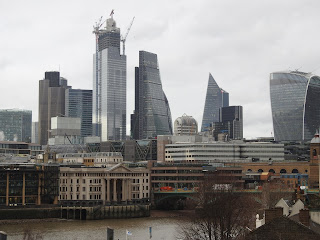The part of the building to the left is the original power station and the extension to the right is the Blavatnik building named after Sir Leonard Blavatnik who donated much of the funds for the development.
This is the Turbine Hall which often houses large installations and site specific works.
This side view fronts onto the Thames (more of which later).
Thanks to my husband for this shot from the escalators cutting through two floors to reach the floor of the turbine hall.
Our first impression of the Tate was its size, it's huge and cavernous! A note for future reference, they allow you to take in small flight size cases but they must be stowed at the cloakroom, which is free and secure but invites donations, currently £4.
I hadn't expected to enjoy the exhibition as much as I did, especially as I only weave on a simple floor loom and not a multi-shafted one but I was fired up by it all.
The exhibition was in the Eyer Ofal Galleries in the Natalie Bell building. The first weaving was Black White Yellow which was rewoven in 1965 by Gunta Stölzl who was Bauhaus Master of Craft in the weaving workshop from 1927 to 1931.
This is a detail of Black White Yellow, woven in cotton and silk. It is 207.6 x 121.4cms I had a lovely chat with 2 ladies as we tried to work out how this was achieved. They were complete novices at weaving and my small knowledge didn't help at all.
Anni's loom was on display and surprisingly (to me) compact. She also wove on much larger and smaller looms.
The Bauhaus was forced to close by the Nazis in 1931 and Anni moved to a teaching position at the Black Mountain College in North Carolina USA.
My greatest fascination in the exhibition was the way the warps were manipulated with the weft threads and which were probably woven on a small handloom. I have tried something similar on my own looms. I particularly like the way she has used the technique for parts of rows and not all the way across the width. It makes for an interesting texture.
This weave and the one below spoke to me a bit of Mondrian's work, notably his Boogie-Woogie works. Above is Open Letter, 1958, cotton, 57.8 x 60cms. It has lots of excitement for me in the texture and I loved the little shots of colour.
Above is titled "Pasture' from1958 measuring 35.6 x 39.4 cms
This image above was wonderfully rich in colour (much stronger than my flashless photograph shows) and is titled Sunny from 1965 in cotton and linen,12.7 x 43.2 cms.
Set in a space of its own, with a large bench in front to allow for contemplation, was the 6 panelled Six Prayers which was made for the Jewish Museum New York to memorialise the 6 million Jews who died in the holocaust. Each panel is 186 x 50 centimetres from cotton and linen threads and highlighted by silver accents.
The detail is sadly out of focus due to the lack of light and no flash. I did like the use she had made wandering threads that are carried along and up the weave.
Alternative materials had figured in some of Anni's early works too, including her diploma piece from the Bauhaus, woven to be soundproofing and to cover the walls in an auditorium.
This fabric looked a bit like a thermal ironing board cover that I used to have and was woven with cotton, chenille and cellophane. It was backed with chenille (velvet in the accompanying description).
The huge space in the gallery was separated by partitions made from wood and sheer fabric that gave interesting veiled views of the visitors and weavings to be explored and also supported some of the more varied weavings.

The piece above is by Lenore Tawney titled Leckythos and woven in 1962 from linen, brass and acrylic. Size 127 x 68cms. A statement by Albers from her book 'On Weaving' suggests that she was aware of this artist's work and the way she was taking weaving forward. With the sheer fabric behind it it looks almost ethereal.
The Anni Albers exhibition ends on Sunday 27th January and I for one wish I had gone much earlier so that I could have had a second visit. There is just so much to see, but I can recommend the exhibition catalogue which is extensive with its illustrations and text. It's a book both to dip into and to enjoy in depth.
Our visit was rounded off with some wonderful views of the opposite bank of the Thames and of The globe Theatre which sadly we didn't have time to visit.
The Globe Theatre (thatched)
City of London School




























4 comments:
What a wonderful way to 'recycle' a disused power station. You must have found the exhibition fascinating. Lovely to see photos of London - I can't remember the last time I was there.
Thanks for taking me with me to this fascinating exhibition! I'm just a bit sad that it is closing down already.
I love her work, and seeing it through your eyes made this blogpost very enjoyable for me.
Take care, Frauke
Thank you so much for this post I have been meaning to go to this exhibition since it started and now I have left it to late. It is lovely to see close ups of her work.
I haven't been to the Tate modern since the extension was added, I really must get myself up to London again.
I saw this exhibition at the end of last year and immediately thought of you Julie. I’m not a weaver but found the work very contemporary looking. It was a fascinating exhibition.
Post a Comment